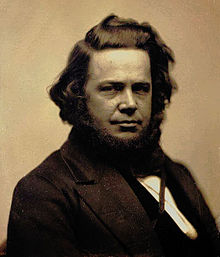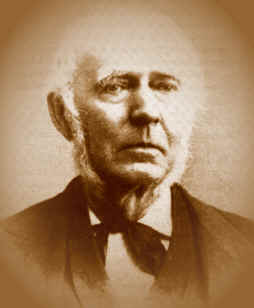Music, Magick, and the Other Elias Howe
 Do you know this guy? His name is Elias Howe, Jr. He lived from 1819 to 1867. He’s famous for taking the idea of a machine that can be used to sew, adding some important innovations (perhaps most importantly, the lock stitch), and patenting the grandfather of all modern sewing machines.
Do you know this guy? His name is Elias Howe, Jr. He lived from 1819 to 1867. He’s famous for taking the idea of a machine that can be used to sew, adding some important innovations (perhaps most importantly, the lock stitch), and patenting the grandfather of all modern sewing machines.
But I don’t want to discuss him. Instead, I’d like to introduce you to another Elias Howe, Jr. He lived from 1820 to 1895. Here’s what he looked like:
 Although they chose to wear a similar style of face hair, they were definitely not the same person and were probably not even related. This second Howe picked up a fiddle when he was a boy and learned by listening to other fiddlers in the New England area. Eventually he published books on the tunes as well as numerous other instructional books and sheet music.
Although they chose to wear a similar style of face hair, they were definitely not the same person and were probably not even related. This second Howe picked up a fiddle when he was a boy and learned by listening to other fiddlers in the New England area. Eventually he published books on the tunes as well as numerous other instructional books and sheet music.
As you may know, most music today is set to one or more keys, a harmonic focus for a section or for an entire work. Each of the keys has variations, so the key of G sharp, (G#), C or B flat (Bb), for example, could be major, minor, diminished, etc. These are derived from the ancient Greeks who had scales with a wider variation than our modern scales. They were called modes, and Plato described the emotions that the different modes could evoke. He said that you shouldn’t mix the modes or even the styles of playing the modes.
In about 1870 Elias Howe Jr. (the fiddler, not the tailor) did the same sort of analysis. He came to these conclusions:
C major is warlike and well adapted to martial music
G major is gay and sprightly and will admit of a greater variety of subjects than any other key
D major is good for music that is grand, solemn, and melancholy
A major is plaintive but lively
E major is the same as A major
F major is sober and thoughtful. It is better adapted for the violin than any other key
Bb major is the same as F major but more plaintive
Eb major is similar to A major but more sweet
He was not alone in trying to analyze the relationship of the keys of music to the emotions they produced. His contemporary, the scientist Hermann von Helmholz gave this:
C major: Pure, certain, decisive; expressive of innocence, powerful resolve, manly earnestness and deep religious feeling
Db major: Fullness of tone, sonority and euphony
E major: Joy, magnificence, splendor; brightest and most powerful key
E minor: Grief, mournfulness, restlessness
F major: Peace, joy, light, passing regret, religious sentiment
F minor: Harrowing, melancholy
F# major: Brilliant, very clear
Gb major: Softness, richness
Two centuries earlier the French Composer Marc-Antoine Charpentier, in a book from about 1682 gave this list:
C major: Gay and warlike
C minor: Obscure and sad
D major: Joyous and very warlike
D minor: Serious and pious
Eb major: Cruel and hard
E major: Quarrelsome and boisterous
E minor: Effeminate, amorous, plaintive
F major: Furious and quick-tempered subjects
F minor: Obscure and plaintive
G major: Serious and magnificent
G minor: Serious and magnificent (curiously the same as G major)
A major: Joyful and pastoral
A minor: Tender and plaintive
B major: Harsh and plaintive
B minor: Solitary and melancholic
Bb major: Magnificent and joyful
Bb minor: Obscure and terrible
And from a book in 1806, German poet Christian Schubart gave this more elaborate list:
C major: Completely pure. Its character is: innocence, simplicity, naïvety, children’s talk
C minor: Declaration of love and at the same time the lament of unhappy love. All languishing, longing, sighing of the love-sick soul lies in this key.
Db major: A leering key, degenerating into grief and rapture. It cannot laugh, but it can smile; it cannot howl, but it can at least grimace its crying. Consequently only unusual characters and feelings can be brought out in this key.
D major: The key of triumph, of Hallejuahs, of war-cries, of victory-rejoicing. Thus, the inviting symphonies, the marches, holiday songs and heaven-rejoicing choruses are set in this key.
D minor: Melancholy womanliness, the spleen and humors brood. [Note: not funny “humors,” rather the ancient concept of the body being filled with four substances, the balance of which determined the character of the person.]
D# minor: Feelings of the anxiety of the soul’s deepest distress, of brooding despair, of blackest depresssion, of the most gloomy condition of the soul. Every fear, every hesitation of the shuddering heart, breathes out of horrible D# minor. If ghosts could speak, their speech would approximate this key.
Eb major: The key of love, of devotion, of intimate conversation with God.
E major: Noisy shouts of joy, laughing pleasure and not yet complete, full delight lies in E major.
F major: Complaisance and calm
F minor: Deep depression, funereal lament, groans of misery and longing for the grave.
F# major: Triumph over difficulty, free sigh of relief utered when hurdles are surmounted; echo of a soul which has fiercely struggled and finally conquered lies in all uses of this key.
F# minor: A gloomy key: it tugs at passion as a dog biting a dress. Resentment and discontent are its language.
G major: Everything rustic, idyllic and lyrical, every calm and satisfied passion, every tender gratitude for true friendship and faithful love—in a word every gentle and peaceful emotion of the heart is correctly expressed by this key. [Note: Uh, sorry, Mr. Schubart, but that’s not “a” word, it’s 14 words!]
G minor: Discontent, uneasiness, worry about a failed scheme; bad-tempered gnashing of teeth; in a word: resentment and dislike. [Note: That’s 3 words, not “a” word.]
Ab major: Key of the grave. Death, grave, putrefaction, judgment, eternity lie in its radius.
Ab minor: Grumbler, heart squeezed until it suffocates; wailing lament, difficult struggle; in a word, the color of this key is everything struggling with difficulty. [Note: I don’t think Mr. Schubart understands want “a word” means.]
A major: This key includes declarations of innocent love, satisfaction with one’s state of affairs; hope of seeing one’s beloved again when parting; youthful cheerfulness and trust in God.
A minor: Pious womanliness and tenderness of character.
Bb major: Cheerful love, clear conscience, hope aspiration for a better world.
Bb minor: A quaint creature, often dressed in the garment of night. It is somewhat surly and very seldom takes on a pleasant countenance. Mocking God and the world; discontented with itself and with everything; preparation for suicide sounds in this key.
B major: Strongly colored, announcing wild passions, composed from the most glaring colors. Anger, rage, jealousy, fury, despair and every burden of the heart lies in its sphere.
B minor: This is, as it were, the key of patience, of calm awaiting ones’s fate and of submission to divine dispensation.
Whether you agree with any of these selections, it is quite clear that music can and does influence your emotions. Recently I’ve been using music from groups such as Nox Arcana and Midnight Syndicate as well as the soundtrack from the first “Hellraiser” movie as backdrops for rituals.
Do you use music in your rituals other than chants and songs?
What kind of music do you use with your rituals?
Do you change depending upon the purpose of your ritual?
Does the key matter to you?
How about the speed and rhythm?








We didn’t seek this out, but after an in-depth exploration it makes sense for us. We think these guys have a real chance to be part of our future. ~ Andrew Friedman obtained from
Exploration Quotes